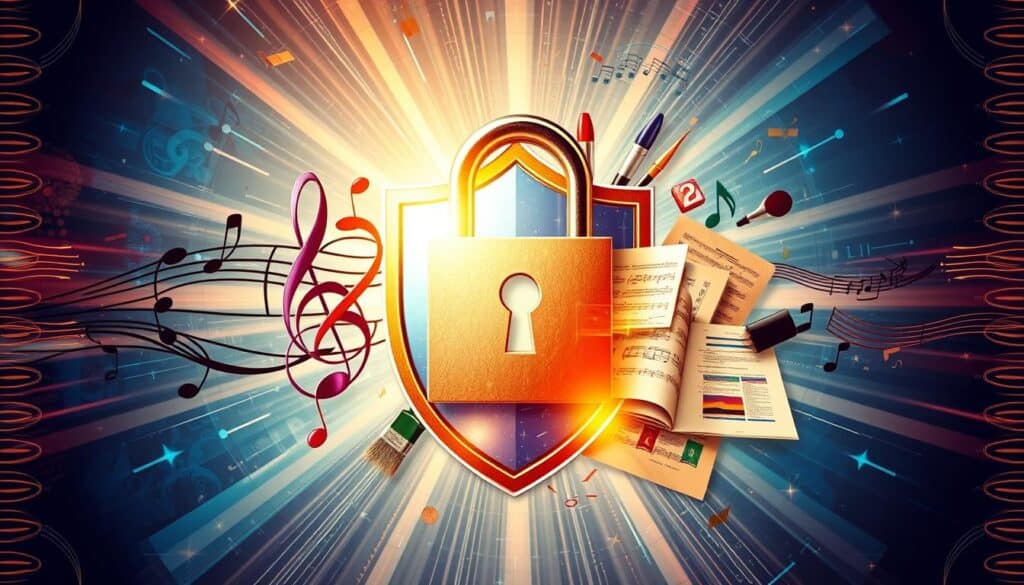In 2022, 3.5 million patents were given out all over the world. This shows how crucial intellectual property is for global innovation. Understanding the patent vs copyright differences is essential for protecting inventions and artistic works. Patents mainly focus on tech advancements. Copyrights protect artistic works.
ومع فهم المبدعين والمخترعين لهذه القوانين، يمكنهم حماية أعمالهم. وتؤدي هذه الحماية إلى مزيد من الإبداع والفرص.
على الرغم من أن كلاهما يندرج تحت الملكية الفكرية، إلا أن براءات الاختراع وحقوق التأليف والنشر تخدم أغراضاً مختلفة. في الولايات المتحدة الأمريكية، تشكل براءات الاختراع حوالي 901 تيرابايت من جميع أشكال الحماية الصادرة. فهي تمنح الحقوق التي تساعد على تحويل الأفكار إلى أصول. ومن ناحية أخرى، يحمي قانون حقوق التأليف والنشر المؤلفين والمبدعين. فهو يمنحهم السيطرة على نسخ أعمالهم ومشاركتها علناً.
شرح براءات الاختراع مقابل حقوق النشر ليس للأكاديميين فقط. إنه أمر بالغ الأهمية لأولئك الذين يرغبون في تعزيز الابتكار وتحقيق أقصى استفادة من جهودهم الفكرية.
النقاط الرئيسية
- حقوق الملكية الفكرية هي مفتاح الحماية القانونية وكسب المال من الاختراعات والأعمال الإبداعية.
- توفر براءات الاختراع حقوقًا حصرية مهمة للابتكار التكنولوجي واستخدامه الصناعي.
- تسمح حقوق التأليف والنشر بالتحكم في نسخ الأعمال الفنية والأدبية الأصلية ومشاركتها.
- يساعد قانون العلامات التجارية الشركات على حماية علامتها التجارية والحفاظ على ثقة المستهلك من خلال التسجيل الفيدرالي.
- يمكن أن تؤثر معرفة الفروق بين براءات الاختراع وحقوق التأليف والنشر والعلامات التجارية بشكل كبير على تكتيكات العمل والحرية الإبداعية.
- تؤثر شروط الحماية القانونية لهذه الحقوق على مدة استمرارها وكيفية إنفاذها.
فهم أساسيات الملكية الفكرية
الملكية الفكرية (IP) هو مجال رئيسي في تعزيز ابتكار والإبداع في مختلف القطاعات. يساعد فهم أساسيات الملكية الفكرية على حماية المنتجات الفريدة والمساعي الإبداعية. وهذا يضمن الحقوق الحصرية وميزة تنافسية.
تعريف الملكية الفكرية (IP)
Intellectual property يحمي الإبداعات في المجالات الصناعية والعلمية والأدبية والفنية. فهي تمنح المبدعين حقوقًا للتحكم في أعمالهم واستخدامها بشكل قانوني. وتغطي هذه الحقوق المنتجات الجديدة والعمليات المبتكرة.
الركائز الأربع للملكية الفكرية: حقوق النشر وبراءة الاختراع والعلامة التجارية والسر التجاري
- حقوق الطبع والنشر:: يحمي مبدعي الأعمال الأصلية مثل الأدب والموسيقى والفن. ويتيح لهم التحكم في إعادة الإنتاج والتوزيع والعرض.
- براءة اختراع:: يمنح المخترعين حقوقًا في اختراعاتهم لمدة تصل إلى 20 عامًا. ويشمل ذلك الآلات أو العمليات أو التركيبات الكيميائية.
- العلامة التجارية:: تحديد مصدر السلع أو الخدمات بعلامات فريدة. ويمكن تسجيل الأسماء والشعارات والرموز للحماية.
- الأسرار التجارية:: تحافظ على سرية المعلومات التجارية، بما في ذلك الصيغ والعمليات. ويوفر ميزة تنافسية.
لماذا من المهم التمييز بين حقوق الملكية الفكرية المختلفة
إن فهم حقوق الملكية الفكرية المختلفة هو مفتاح الحماية القانونية المناسبة. على سبيل المثال، تحمي حقوق الطبع والنشر التعبير عن فكرة العمل الإبداعي. بينما تحمي براءات الاختراع الاختراعات التقنية الجديدة والمفيدة. إن معرفة الاختلافات أمر بالغ الأهمية لتعظيم إمكانات الابتكار.
تضمن هذه المعرفة الامتثال للقوانين وحماية الأصول من سوء الاستخدام. إن وجود حماية كاملة للملكية الفكرية يعزز ثقافة النزاهة والابتكار.
ما هي حماية حقوق الطبع والنشر؟
يكشف استكشاف قانون حقوق النشر كيف تحافظ حماية حقوق النشر على سلامة الإبداعات الأصلية. فهي تضمن الحفاظ على اللمسة الفريدة وأصالة الأعمال مثل الكتب أو الأغاني أو المسرحيات. وهذا أمر حيوي للمبدعين للحفاظ على مساهماتهم الفريدة.
مفهوم الأصالة في الأعمال الإبداعية
في قانون حقوق الطبع والنشر, الأصالة هو مفتاح الحصول على الحماية. يجب أن يُظهر العمل مهارة المبدع وحكمه الخاص. لا يكفي مجرد نسخ الأعمال الموجودة. حقوق التأليف والنشر تحمي كيفية عرض الأفكار وليس الأفكار نفسها، على عكس براءات الاختراع.

نطاق وحدود قانون حقوق الطبع والنشر
ال نطاق قانون حقوق النشر واسعة. فهو يغطي أعمالاً مثل الكتب والمسرحيات والموسيقى والفن. يمكن للمؤلفين التحكم في استخدام أعمالهم والحصول على أجر. تهدف قوانين حقوق النشر إلى تحفيزهم اقتصاديًا. ومع ذلك، هناك حدود مثل الاستخدام العادل، الذي يتيح للأشخاص استخدام بعض المواد المحمية بحقوق الطبع والنشر دون الحاجة إلى إذن.
يساعدك فهم هذه التفاصيل على فهم قواعد حقوق النشر بشكل أفضل.
الاستفادة من التسجيل لدى مكتب حقوق الطبع والنشر الأمريكي
تبدأ حقوق الطبع والنشر بمجرد إنشاء العمل وتثبيته في شكل ملموس. ولكن، التسجيل لدى مكتب حقوق الطبع والنشر الأمريكي يعزز هذه الحماية. التسجيل هو المفتاح لاتخاذ الإجراءات القانونية أو التعامل مع قضايا حقوق الطبع والنشر. فهو يعزز الصلة بين امتلاك الحقوق والقدرة على إنفاذها.
| وجه | التفاصيل |
|---|---|
| ضرورة التسجيل | طوعية، ولكنها مطلوبة للتقاضي |
| الحماية عند الإنشاء | حق تلقائي عند إنشاء العمل وتثبيته |
| مدة حقوق الطبع والنشر | عمر المبدع بالإضافة إلى 70 سنة، حتى 95 أو 120 سنة بالنسبة للأعمال المؤجرة |
| الأضرار القانونية | متاح عند التسجيل |
| نطاق القانون | الأعمال الأدبية والدرامية والموسيقية والفنية |
تسجيل حقوق النشر أمر بالغ الأهمية. فهو يدعم الحقوق المعنوية والقانونية للمبدعين. وهذا يساعدهم على حماية الأصالة من الأعمال الإبداعية.
الإبحار في قانون براءات الاختراع
يعزز عالم قانون براءات الاختراع الابتكار والتقدم التكنولوجي. فهو يمنح المخترعين حقوقاً حصرية لأعمالهم. إن معرفة أنواع براءات الاختراع وكيفية الحصول عليها من مكتب براءات الاختراع والعلامات التجارية الأمريكي أمر أساسي للمخترعين.
توجد ثلاث براءات اختراع رئيسية في الولايات المتحدة: براءات اختراع المنفعة والتصميم وبراءات اختراع المصنع. براءات اختراع المنفعة هي الأكثر شيوعاً، وتغطي العمليات والآلات الجديدة. براءات اختراع التصميم تحمي شكل المنتج. أما براءات اختراع النباتات فهي لأنواع جديدة من النباتات التي لا تتكاثر بالبذور.
ال قانون الاختراعات الأمريكية نظام براءات الاختراع في الولايات المتحدة. والآن، أصبح الأمر يتعلق بمن يقدم الملفات أولاً، وليس من يخترع أولاً. وهذا يجعل الإيداع بسرعة مع مكتب براءات الاختراع والعلامات التجارية الأمريكي مهم جداً
| نوع براءة الاختراع | الحماية المقدمة | مدة |
|---|---|---|
| براءة اختراع المنفعة | الجوانب الوظيفية للاختراعات | 20 سنة |
| براءة اختراع التصميم | المظهر الجمالي للأشياء | 15 سنة |
| براءة اختراع النبات | أصناف جديدة من النباتات | 20 سنة |
الحصول على براءة اختراع أمر صعب وغالباً ما يتطلب محامياً. محامي براءات اختراع جيد أمر ضروري. فهم يتأكدون من حماية اختراعك بشكل صحيح، باتباع قواعد مكتب براءات الاختراع والعلامات التجارية الأمريكي.
لا تساعد قوانين براءات الاختراع المخترعين على الاحتفاظ بحقوقهم الحصرية فحسب. فهي تعزز أيضاً الابتكار والنمو الاقتصادي دون توقف.
مجال العلامات التجارية وعلامات الخدمة
العلامات التجارية و علامات الخدمة مهمة جدًا في عالم الأعمال. فهي تساعد في تحديد العلامة التجارية وإظهار سمعة الشركة والجودة التي تقدمها. فهي تجعل العلامة التجارية متميزة عن غيرها من العلامات التجارية الأخرى، مما يبني ولاء العملاء وثقتهم.
تحديد مصدر السلع والخدمات
العلامات التجارية و علامات الخدمة أساسية في إظهار مصدر المنتج أو الخدمة. وهذا يساعد المستهلكين على الاختيار بناءً على أسماء العلامات التجارية. ويتأثر هذا الاختيار بمدى تعرفهم على العلامة التجارية وثقتهم بها.
المزايا القانونية لتسجيل علامة تجارية لدى USPTO
هناك العديد من الفوائد لتسجيل علامة تجارية لدى مكتب الولايات المتحدة الأمريكية لتسجيل العلامات التجارية. فهو يوفر حماية على الصعيد الوطني، وهو أمر مهم للغاية للحفاظ على العلامة التجارية آمنة في الولايات المتحدة. يساعد هذا الوضع الفيدرالي على منع الآخرين من استخدام علامتك ويجعل الإجراءات القانونية أسهل إذا لزم الأمر. كما أن تسجيل مكتب الولايات المتحدة الأمريكية لتسجيل العلامات التجارية يثبت امتلاكك للعلامة...
لقد قرأت 30% من المقال. الباقي لمجتمعنا. هل أنت عضو بالفعل؟ تسجيل الدخول
(وأيضًا لحماية المحتوى الأصلي لدينا من روبوتات الكشط)
مجتمع الابتكار العالمي
تسجيل الدخول أو التسجيل (100% مجاناً)
اطلع على بقية هذه المقالة وجميع المحتويات والأدوات الخاصة بالأعضاء فقط.
فقط المهندسون والمصنعون والمصممون والمسوقون الحقيقيون المحترفون.
لا روبوت، ولا كاره، ولا مرسل رسائل غير مرغوب فيها.
التعليمات
ما هي الاختلافات الرئيسية بين براءة الاختراع وحقوق التأليف والنشر؟
براءات الاختراع هي للاختراعات الجديدة مثل الآلات أو المواد الكيميائية. فهي تساعد في الابتكار والتقدم. تحمي حقوق التأليف والنشر الأعمال الإبداعية مثل الكتب والموسيقى والفن. وهي تركز على حقوق المبدع.
ما هي الملكية الفكرية (IP)؟
تتعلق الملكية الفكرية بأفكار وإبداعات عقلك. وهي تشمل الاختراعات والأعمال الفنية والتصاميم. وتمنح الملكية الفكرية للمبدع حقوقاً خاصة لعمله.
لماذا من المهم فهم الأنواع المختلفة لحقوق الملكية الفكرية؟
تساعد معرفة حقوق الملكية الفكرية المبدعين على حماية أعمالهم. ويتيح لهم استخدام الطرق القانونية للدفاع عن حقوقهم. ويمكنهم أيضاً تحقيق أكبر قدر من المال من إبداعاتهم.
ما الذي يشكل الأصالة في الأعمال الإبداعية المؤهلة لحماية حقوق الطبع والنشر؟
الأصالة تعني أن المؤلف قام بالعمل من تلقاء نفسه، مع بعض الإبداع. ليس من الضروري أن يكون العمل جديدًا تمامًا، ولكن ليس من الضروري أن يكون منسوخًا.
ما هي فوائد تسجيل مصنف لدى مكتب حقوق الطبع والنشر الأمريكي؟
يمنحك التسجيل سجلاً عاماً لحقوق الطبع والنشر. ويمكن أن يعني فوائد قانونية كبيرة، مثل التعويضات المالية في المحكمة. ولكن يجب عليك التسجيل قبل أي انتهاك أو في غضون ثلاثة أشهر من النشر.
ما هي الحقوق التي يتمتع بها صاحب براءة الاختراع؟
يمكن لصاحب براءة الاختراع منع الآخرين من استخدام اختراعه لمدة 20 عاماً. وهذا يعني أن بإمكانهم كسب المال منه فقط.
ما أهمية تسجيل العلامات التجارية وعلامات الخدمة؟
يمنحك التسجيل مزايا قانونية. فيمكنك امتلاك العلامة في كل مكان في الولايات المتحدة، كما أنه يساعدك في المحكمة وفي التسجيل في بلدان أخرى.
كيف تتداخل حقوق الطبع والنشر مع قانون العلامات التجارية؟
في بعض الأحيان تغطي قوانين حقوق النشر والعلامة التجارية نفس الشيء. كما هو الحال عندما يكون شكل الشعار محمي بحقوق الطبع والنشر ولكنه يستخدم أيضاً كعلامة تجارية.
ما هو دور مكتب الولايات المتحدة لبراءات الاختراع والعلامات التجارية (USPTO) في براءات الاختراع؟
يتحقق مكتب براءات الاختراع الأمريكي من براءات الاختراع لمعرفة ما إذا كانت قانونية. فهم يمنحون براءات الاختراع لحماية الاختراعات. كما أنهم يتعاملون مع جميع سجلات براءات الاختراع.
ما هي مدة حماية حقوق الطبع والنشر وبراءات الاختراع؟
تستمر حقوق الطبع والنشر مدى حياة المؤلف بالإضافة إلى 70 عاماً. وتستمر براءات الاختراع لمدة 20 عاماً من وقت تقديم الطلب، إذا دفعت الرسوم.
متى يجب استخدام الأسرار التجارية بدلاً من براءات الاختراع أو حقوق النشر؟
استخدم الأسرار التجارية عندما تريد الحفاظ على سرية المعلومات إلى الأبد. فهي محمية طالما كانت ذات قيمة وسرية.
كيف يمكن أن يؤثر فهم التفاعل بين قوانين الملكية الفكرية المختلفة على حماية الملكية الفكرية؟
تساعدك معرفة كيفية عمل قوانين الملكية الفكرية معًا على حماية إبداعاتك وإدارتها بشكل أفضل. وهذا يعني أنه يمكنك استخدام حقوقك بشكل أكثر فعالية.
كيف يمكن أن توفر الاستفادة من حقوق الملكية الفكرية ميزة تنافسية في مجال الأعمال التجارية؟
تمنحك حقوق الملكية الفكرية التحكم في إبداعاتك وحماية أعمالك. فهي تجعل منتجاتك أكثر قيمة. كما أنها تساعد في تحقيق أرباح جديدة وبناء علامتك التجارية.
روابط خارجية حول حماية الملكية الفكرية
المعايير الدولية
(حرك الرابط لرؤية وصفنا للمحتوى)
مسرد المصطلحات المستخدمة
Digital Rights Management (DRM): مجموعة من تقنيات التحكم في الوصول المستخدمة لحماية المحتوى الرقمي المحمي بحقوق الطبع والنشر من الاستخدام غير المصرح به والنسخ والتوزيع، مما يضمن أن المبدعين والموزعين يحتفظون بالسيطرة على حقوق الملكية الفكرية الخاصة بهم.
Fair Use Doctrine: مبدأ قانوني يسمح بالاستخدام المحدود للمواد المحمية بحقوق الطبع والنشر دون إذن من صاحب الحقوق، وعادةً لأغراض مثل النقد أو التعليق أو التقارير الإخبارية أو التدريس أو المنح الدراسية أو البحث، مع تحقيق التوازن بين مصالح أصحاب حقوق الطبع والنشر والجمهور.
Non-Disclosure Agreement (NDA): عقد قانوني يُرسي علاقة سرية بين الأطراف، ويحظر الكشف عن معلومات محددة لأطراف ثالثة. ويُستخدم عادةً لحماية المعلومات الحساسة المُتبادلة أثناء المفاوضات التجارية أو التعاون.
Public Domain: وضع قانوني يُشير إلى تحرر الأعمال من قيود حقوق النشر، مما يسمح لأي شخص باستخدامها وتعديلها وتوزيعها دون إذن أو مقابل. قد ينشأ هذا الوضع نتيجة انتهاء صلاحية حقوق النشر، أو إهداء صريح من المُبدع، أو عدم أهلية العمل لحقوق النشر.
Unique Selling Point (USP): ميزة أو فائدة مميزة تجعل المنتج أو الخدمة متميزًا عن المنافسين، وتهدف إلى جذب العملاء من خلال معالجة احتياجات أو تفضيلات محددة.
United States Patent & Trademark Office (USPTO): الوكالة الفيدرالية المسؤولة عن منح براءات الاختراع وتسجيل العلامات التجارية في الولايات المتحدة، وتشجيع الابتكار وحماية حقوق الملكية الفكرية. تفحص الطلبات، وتصدر براءات الاختراع، وتحتفظ بقاعدة بيانات للعلامات التجارية المسجلة.
User Interface (UI): نظام يتيح التفاعل بين المستخدمين وتطبيقات البرامج، ويشمل عناصر مرئية، وأدوات تحكم، وتخطيطًا عامًا لتسهيل مهام المستخدم وتحسين التجربة.



























السياقات الدولية؟
من المفيد التعمق أكثر في الاختلافات الدولية في هذه القوانين
منشورات ذات صلة
أحدث المنشورات وبراءات الاختراع حول النقاط الكمية
أحدث المنشورات وبراءات الاختراع عن البيروفسكايت
أحدث المنشورات وبراءات الاختراع عن الجرافين
أكثر من 45 حيلة علمية للألعاب والتسويق: حيل تعتمد على البيانات والإحصائية
استخدام أو إساءة استخدام 25 تحيزًا إدراكيًا في تصميم المنتجات وتصنيعها
معادلة الرفع المنقحة للمعهد الوطني للسلامة والصحة المهنية في بيئة العمل